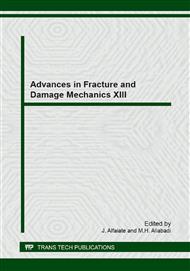p.413
p.417
p.421
p.425
p.429
p.433
p.437
p.441
p.445
Very High Plastic Strain Zones in 304 Stainless Steel Small Punch Specimen Loaded at RT by Martensite Formation and Recrystallization Technique
Abstract:
Very high plastic strain zones with equivalent plastic strain above 0.2, PZ0.2 and above 0.5, PZ0.5 in 304 stainless steel small punch specimens loaded at RT to various level were observed and measured by martensite formation and recrystallization technique, respectively. It is found that both the very high plastic zones are formed ,at middle stage of the small punch test, at first near the outer surface region of the specimen where the loading ball is contacted to the specimen. The zones extend with increasing load toward the inner surface. Thus the contact area part of the specimen with the ball causes a significant strain gradient through thickness. This will be due to the constraint of the plastic deformation near the contact region by the friction force.
Info:
Periodical:
Pages:
429-432
Citation:
Online since:
September 2014
Authors:
Price:
Сopyright:
© 2015 Trans Tech Publications Ltd. All Rights Reserved
Share:
Citation:


